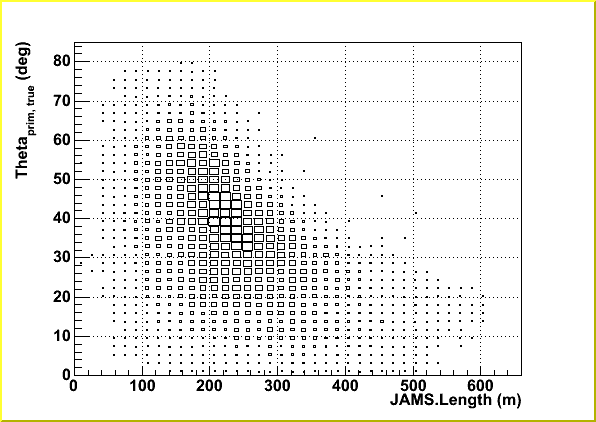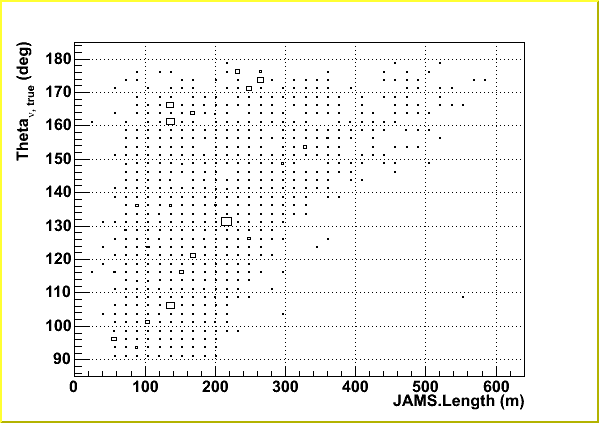In
this page we compare the performance of JAMS and Direct Walk in order
to define the best strategy for the Level 1 analysis in the
filtering of the 2005 data. This strategy will be used to make the cut
which removes most of the down-going muon background (at L1).
Three samples have been used:
The aspects we want to compare are the fake rate (both for down-going and up-going events), the efficiency, the angular resolution, and the processing time. These results can be also used to compare the old and new versions of DW and the classic and SLART version of Sieglinde.
Processing time
Sobol in JAMS
Two tests have been also done to chech if the implementation of the Sobol randomization in JAMS improves the results.
Conclusions
The results of this study show that the performance of both strategies is very similar. DW has a better angular resolution for down-going events which could make it better for first guessing. On other hand, JAMS has a better fake rate both for up-going, which could be used to set the cut in the zenith angle to remove the bulk of the down-going atmospheric muons. JAMS has also slightly better efficiency for down-going muons. The angular resolution of the Likelihood-base strategies is very similar when they are fed by JAMS or DW. The difference in the processing time are not large enough to have an impact in the decision.
Three samples have been used:
- Down-going atmospheric muons analyzed with classic Sieglinde (Old DW, new DW and JAMS)
- Down-going atmospheric muons analyzed with SLART Sieglinde (new DW, JAMS, Single LH, Iterative LH and Paraboloid)
- Up-going
neutrinos generated with spectral index=-2 and analyzed with SLART
Sieglinde (new DW, JAMS, Single LH, Iterative LH and Paraboloid)
The aspects we want to compare are the fake rate (both for down-going and up-going events), the efficiency, the angular resolution, and the processing time. These results can be also used to compare the old and new versions of DW and the classic and SLART version of Sieglinde.
| Sieglinde version |
Strategy |
Angular resolution |
Efficiency (%) |
Fake rate (%) | |
| Atmospheric down-going muons |
Classic |
JAMS |
7.33±0.04 | 97.7±0.7 | 0.83±0.05 |
| New DW |
5.50±0.03 | 96.5±0.7 | 0.84±0.05 | ||
| Old DW |
5.60±0.03 | 99.7±0.7 | 0.96±0.05 | ||
| SLART |
JAMS |
7.34±0.05 | 97.8±0.7 | 0.84±0.05 | |
| DW |
5.50±0.03 | 96.5±0.7 | 0.84±0.05 | ||
| Up-going neutrinos (E-2) |
SLART |
JAMS (length>132) |
6.5±0.1 | 61±2 | 3.7±0.5 |
| DW (length>166) |
6.5±0.1 | 61±2 | 4.5±0.5 |
- The cut used for down-going muons is just to require that had triggered AMANDA.
- In the case of up-going neutrinos, a cut as smooth as the one used with the down-going muons leads to a worse angular resolution (JAMS: 9.6°, DW: 9.0°) and fake-rejection (JAMS: 9.2%, DW: 10.4%).
-
The reason seems to be the different angular distribution of the
events reaching the detector. There are much more events close to the
horizon in the case of up-going neutrinos, which have typically shorter
tracks and therefore, bad angular resolution. Thus, a cut in the length
is used. The cut values in the length are chosen so that they provide a
similar efficiency. Here are shown some results using the same length.
 |
 |
| Zenith
angle versus length of the track calculated by JAMS for down-going
primaries (left) and up-going neutrinos (right). It can be seen that the
events near the horizon have typically shorter tracks (due to the
geometry of the detector). These events are relatively more frequent in the
up-going case, which detereiorates the average angular resolution and
fake rates. |
|
Processing time
One file containting more than 120k events was used to test the speed of JAMS and DW:
| JAMS |
19 min |
| DW |
13 min |
Sobol in JAMS
Two tests have been also done to chech if the implementation of the Sobol randomization in JAMS improves the results.
- Down-going muon tracks
| Angular resolution |
Efficiency |
Fake rate |
|
| Normal JAMS |
7.34±0.05 | 97.8±0.7 | 0.84±0.05 |
| Sobol JAMS |
8.7±0.05 | 97.0±0.7 | 1.08±0.05 |
For down-going muons, the
angular resolution with Sobol is worse, although the quality of the
LogLikelihood reconstruction fed by the normal and the Sobol JAMS is
very similar. Moreover, the fake rate is worse for Sobol.
For up-going neutrinos, the angular resolution is better for JAMS without Sobol. The efficiency and the fake rates are the same within the statistical errors.
Correlations between JAMS and DW in the fake events
We have also studied the correlation between the fake events in JAMS and DW:
We see then that the correlation is indeed small, which suggests to use both strategies to avoid reduce the number of fake events.
For up-going events (using E-1 spectrum and no cut in the length), we would have:
Therefore, we have estimated that the effect of requiring a track to be reconstructed as up-going by JAMS and DW means a reduction of ~6% in a E-2 signal (using a cut the length like LJAMS>132 or LDW>166) to compare with the loss of ~4% that we have with requirement in only one strategy.
- Up-going neutrino tracks
| Angular resolution |
Efficiency |
Fake rate |
|
| Normal JAMS (L>132) |
6.5±0.1 | 61±2 | 2.3±0.3 |
| Sobol JAMS (L>132) |
7.1±0.1 | 61±3 | 2.1±0.5 |
For up-going neutrinos, the angular resolution is better for JAMS without Sobol. The efficiency and the fake rates are the same within the statistical errors.
Correlations between JAMS and DW in the fake events
We have also studied the correlation between the fake events in JAMS and DW:
| no fake with any |
33269 |
| no fake with JAMS but fake with DW |
226 |
| fake with JAMS but not with DW |
220 |
| fake with both |
49 |
We see then that the correlation is indeed small, which suggests to use both strategies to avoid reduce the number of fake events.
For up-going events (using E-1 spectrum and no cut in the length), we would have:
| no fake with any |
21916 |
| no fake with JAMS but fake with DW |
2223 |
| fake with JAMS but not with DW |
1770 |
| fake with both |
1252 |
Therefore, we have estimated that the effect of requiring a track to be reconstructed as up-going by JAMS and DW means a reduction of ~6% in a E-2 signal (using a cut the length like LJAMS>132 or LDW>166) to compare with the loss of ~4% that we have with requirement in only one strategy.
The results of this study show that the performance of both strategies is very similar. DW has a better angular resolution for down-going events which could make it better for first guessing. On other hand, JAMS has a better fake rate both for up-going, which could be used to set the cut in the zenith angle to remove the bulk of the down-going atmospheric muons. JAMS has also slightly better efficiency for down-going muons. The angular resolution of the Likelihood-base strategies is very similar when they are fed by JAMS or DW. The difference in the processing time are not large enough to have an impact in the decision.